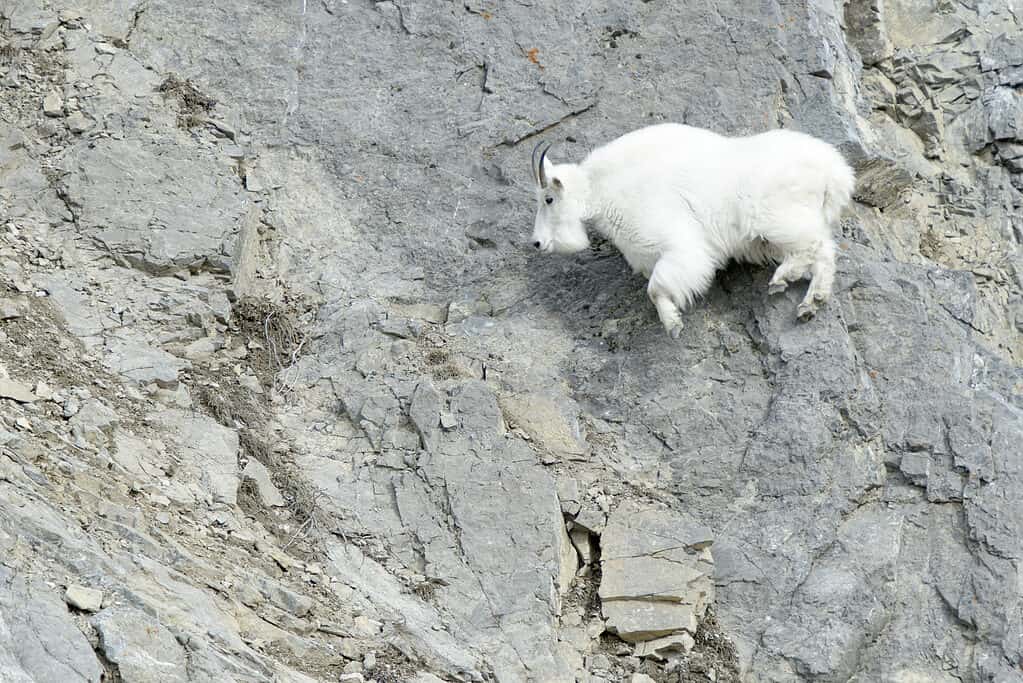Rocky Mountain goats are fascinating creatures found in the mountainous regions of North America, including Montana. Montana’s diverse terrain and abundance of high-altitude areas make it an ideal habitat for these animals.
This article will provide insights into the hunting practices, behavior, and physical attributes of Rocky Mountain goats in Montana, including the largest one ever caught.

Rocky Mountain goats are as majestic and strong as the mountains, with their thick fur and long horns
©Diane Garcia/Shutterstock.com
Rocky Mountain Goats in Montana
The Rocky Mountain goats have adapted well to living in the mountains. They are as majestic and strong as the mountains, with their thick fur and long horns. An adult male goat can weigh up to 240 pounds and stand up to five feet tall.
Rocky Mountain Goats living in Montana eat grasses, lichens, and sometimes flowers and shrubs. During the summer, they eat grass that grows at higher altitudes while preferring lichens during winter.
The Largest Rocky Mountain Goat Ever Caught in Montana
In 2023, the Boone and Crockett Club’s special judges panel declared a new world record Rocky Mountain goat. The announcement was made at the Sheep Show in Reno, Nevada, at the Wild Sheep Foundation. Justin Kallusky from British Columbia owns the new record-breaking goat. His score was a whopping 60-4/8 points, beating the previous world record by three points. The goat’s horns are over 12 inches long each, making it an extraordinary example.
Previously, the world record for the largest horns on a goat was held by a score of 54, which was caught near the Stikine River in British Columbia.
This new world record goat caught in Montana marks a milestone for hunters. It is a reminder that anyone can hunt and catch a trophy-sized Rocky Mountain goat with dedication and knowledge.
Insights into the Hunting Practices
Hunting can be useful for managing and conserving wildlife, although it can be controversial. Keeping records of big game hunts is critical for managing and understanding wildlife populations. It also helps hunters gauge the ethics and sustainability of their practices and achieve their goals.
The Boone and Crockett Club promotes ethical and sustainable hunting practices and keeps track of the largest animals taken in each species. These practices help hunters gauge their accomplishments while ensuring their hunting practices align with wildlife management and conservation efforts.
Behavior and Physical Attributes

What’s impressive is how they can climb around the mountains like it’s no big deal.
©AndreAnita/Shutterstock.com
The Rocky Mountain goats are remarkable animals with individual behaviors and physical traits. Their white fur enables them to camouflage with the snowy background. Their long horns are a remarkable feature distinguishing them from other goat species. They are excellent climbers in rugged and steep areas.
These goats are herbivores and eat various plants and shrubs in their mountainous habitat. Rocky Mountain goats weigh from 200 to 300 pounds on average. Females weigh 125 to 200 pounds. They can reach a height of up to 3.5 feet at the shoulder and a length of up to 5.5 feet.
The goats’ strong and unique hooves allow them to easily climb steep and rocky surfaces, while their acute sense of smell and hearing aids them in finding food and detecting predators.
Conservation Efforts
Rocky Mountain goats are not considered endangered, but their populations have declined in some areas due to habitat loss, disease, and climate change. Efforts are being made to conserve and manage these populations, including monitoring hunting practices and preserving their habitats.
In Montana, the Rocky Mountain Goat Alliance is a non-profit organization that conserves and manages Rocky Mountain goat populations. The organization works with landowners, government agencies, and other stakeholders to promote sustainable hunting practices and habitat conservation.
Where is Montana Located on a Map?
Montana, located in the western region of the United States, is characterized by its varied landscape that encompasses both the Rocky Mountains and the Great Plains. This state boasts expansive and unspoiled areas, including Glacier National Park, an extensive wilderness area that extends into Canada.
Here is Montana on a map:
Conclusion
Montana’s diverse terrain and thriving population of Rocky Mountain goats make it an excellent location for hunting and wildlife watching. The largest Rocky Mountain goat ever caught in Montana is an impressive specimen that highlights the beauty and majesty of these creatures. By respecting and admiring these animals and supporting ethical and sustainable hunting practices, we can help ensure they thrive for generations.
Rocky Mountain goats are fascinating creatures with unique physical attributes and behaviors that make them perfectly adapted to living in mountainous regions. Conservation efforts are in place to protect these animals and their habitats. It is essential to continue supporting these efforts to ensure that Rocky Mountain goats continue to thrive in the wild.
In conclusion, the largest Rocky Mountain goat ever caught in Montana is a testament to the beauty and resilience of these creatures. By conserving and protecting Rocky Mountain goats and their habitats, we can ensure these magnificent animals continue to thrive for future generations to appreciate and admire.
The photo featured at the top of this post is © Eivor Kuchta/Shutterstock.com
Thank you for reading! Have some feedback for us? Contact the AZ Animals editorial team.






